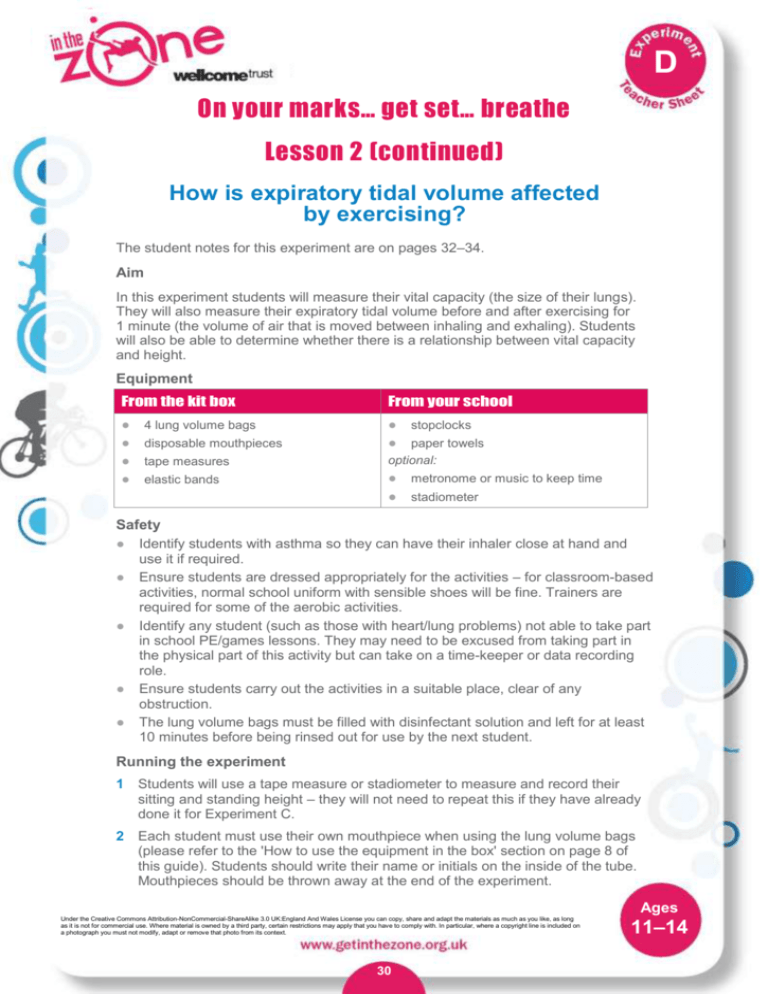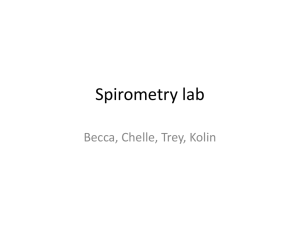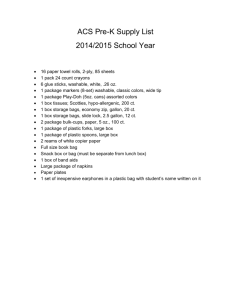word - In the Zone
advertisement

D On your marks… get set… breathe Lesson 2 (continued) How is expiratory tidal volume affected by exercising? The student notes for this experiment are on pages 32–34. Aim In this experiment students will measure their vital capacity (the size of their lungs). They will also measure their expiratory tidal volume before and after exercising for 1 minute (the volume of air that is moved between inhaling and exhaling). Students will also be able to determine whether there is a relationship between vital capacity and height. Equipment From the kit box From your school ● ● ● ● ● ● stopclocks ● ● metronome or music to keep time 4 lung volume bags disposable mouthpieces tape measures elastic bands paper towels optional: stadiometer Safety ● Identify students with asthma so they can have their inhaler close at hand and use it if required. ● Ensure students are dressed appropriately for the activities – for classroom-based activities, normal school uniform with sensible shoes will be fine. Trainers are required for some of the aerobic activities. ● Identify any student (such as those with heart/lung problems) not able to take part in school PE/games lessons. They may need to be excused from taking part in the physical part of this activity but can take on a time-keeper or data recording role. ● Ensure students carry out the activities in a suitable place, clear of any obstruction. ● The lung volume bags must be filled with disinfectant solution and left for at least 10 minutes before being rinsed out for use by the next student. Running the experiment 1 Students will use a tape measure or stadiometer to measure and record their sitting and standing height – they will not need to repeat this if they have already done it for Experiment C. 2 Each student must use their own mouthpiece when using the lung volume bags (please refer to the 'How to use the equipment in the box' section on page 8 of this guide). Students should write their name or initials on the inside of the tube. Mouthpieces should be thrown away at the end of the experiment. Ages Under the Creative Commons Attribution-NonCommercial-ShareAlike 3.0 UK:England And Wales License you can copy, share and adapt the materials as much as you like, as long as it is not for commercial use. Where material is owned by a third party, certain restrictions may apply that you have to comply with. In particular, where a copyright line is included on a photograph you must not modify, adapt or remove that photo from its context. 30 11–14 D 3 Students will use the lung volume bags to obtain measurements for their vital capacity and their expiratory tidal volume. 4 You might like to show students the lung volume bags first and ask them to make a prediction of their vital capacity. 5 See the Student sheet on pages 32–34 for the protocol for obtaining lung volume using the equipment provided. In addition you should be aware that: a The lung volume bag must be airtight when set up. Following the protocol given on the Student sheet should achieve this. b Students must ensure that the bag is entirely empty of air before taking their measurements. c Students must be standing to carry out the test. d Gardening wire can be used to secure the mouthpiece to the lung volume bags by students who are allergic to latex. 6 See the Student sheet on pages 33–34 for the protocol for obtaining expiratory tidal volume using the lung volume bags provided. In addition you should be aware that: a Students must ensure that the lung volume kit is assembled with their own mouthpiece and that any air has been emptied out of the bag before they start taking measurements. b Students must breathe as normally as possible during the experiment. They should practise the technique of breathing in through their nose and out through their mouth before attempting to measure their expiratory tidal volume using the lung volume bag. c Remind students to hold the bag to prevent any air escaping once they have completed their breaths into it. 7 Students who either fill the lung volume bag or don't breathe in a measurable amount of air may need to change the number of breaths they take into the bag and adjust their calculations accordingly. 8 As an alternative to disinfecting each lung volume bag before reuse, each student could breathe into their own large plastic bag, e.g. food or bin liner bag. The bag should be connected, by their own mouthpiece using elastic bands (or gardening wire if students are allergic to latex) to the lung volume bag. The air can then be squeezed out of the plastic bag into the lung volume bag and the volume measured. Expected results Vital capacity is usually related to the size of a person. Therefore, the taller the student, the larger their vital capacity will be and vice versa. Expiratory tidal volume will be greater in students who have been exercising at a high intensity. This is because they will have been breathing more air in as their inspiratory tidal volume in order to supply their working muscles with oxygen. When they stop exercising they will be breathing out greater quantities of carbon dioxide compared to students who have been exercising at a lower intensity. National data upload Your students can enter their lung volume results from this experiment, together with data from Experiment C, into the ‘Live Data Zone’ section of the In the Zone website (www.getinthezone.org.uk). See Teacher notes on page 35 for 11–14 Lesson 3. Ages 11–14 31







